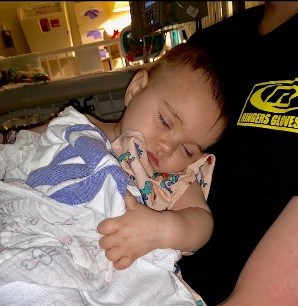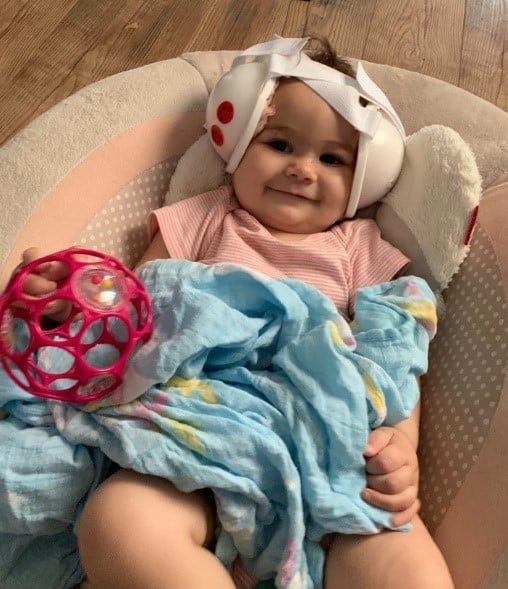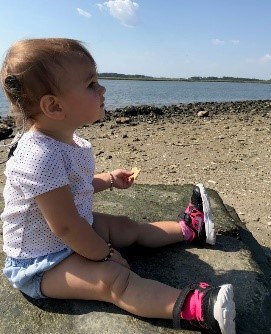After Katelynne C. found out her child, Beverly, had bacterial meningitis, the first priority was ensuring she recovered and was healthy again. After finding out that she also had severe to profound hearing loss, Beverly’s audiologist and doctors urged them to move quickly on cochlear implantation as Beverly’s cochleas could ossify. See how Katelynne made the decision for Beverly’s hearing future:
“One of the very first things Beverly’s infectious disease doctor told my husband and I when she was diagnosed with bacterial meningitis was that she would need to get her ears checked before we went home. I heard what he said, but it was the last thing on my mind. My daughter, who was almost walking a day ago, was not even able to hold her own head up anymore. Her ears were the least of my concerns. Those weeks in the hospital were terrifying. Every second of every day was filled with anxiety and sadness, and it is a miracle that we were able to bring our little girl home.
 Beverly was diagnosed with two viral infections at our local emergency room. She was given IV fluids and monitored overnight because of her weakened appearance. When she did not improve the following day, she was transferred to a bigger children’s hospital. There, Bevy was diagnosed with bacterial meningitis, bacteremia and seizure-like activity. Two days later, she was diagnosed with sepsis and a septic hip. She needed emergency surgery for her hip, so they could clear the infection and place a drain in her hip. After about seven or eight days of IV antibiotics twice a day, we started seeing some improvements. She was staying awake a little longer, nursing more and even playing with a few light-up toys.
Beverly was diagnosed with two viral infections at our local emergency room. She was given IV fluids and monitored overnight because of her weakened appearance. When she did not improve the following day, she was transferred to a bigger children’s hospital. There, Bevy was diagnosed with bacterial meningitis, bacteremia and seizure-like activity. Two days later, she was diagnosed with sepsis and a septic hip. She needed emergency surgery for her hip, so they could clear the infection and place a drain in her hip. After about seven or eight days of IV antibiotics twice a day, we started seeing some improvements. She was staying awake a little longer, nursing more and even playing with a few light-up toys.
Realizing Bevy was not responding to sound
 I am not sure when I realized that Bevy was not responding to sound, but I think it was after about a week in the hospital. I noticed she would not turn to the sound of my voice or even turn to her name being called. My husband and I tried testing her hearing by making loud noises from across the room and yelling her name. We could tell she was not hearing like she was before she was sick, but we were not ready to say she was deaf. I finally asked the doctor when she would go in for a hearing test.
I am not sure when I realized that Bevy was not responding to sound, but I think it was after about a week in the hospital. I noticed she would not turn to the sound of my voice or even turn to her name being called. My husband and I tried testing her hearing by making loud noises from across the room and yelling her name. We could tell she was not hearing like she was before she was sick, but we were not ready to say she was deaf. I finally asked the doctor when she would go in for a hearing test.
We were scheduled for a hearing test the day after we brought it up. Beverly sat on my lap in a quiet sound booth and just looked around. Now that we have been in the sound booth a few times, I know what she was supposed to do. She was supposed to react to sound, by looking in the direction of the sound at images lighting up. She did not react to a single sound. Still, they did not come right out and say she was deaf. They told me that because she was not sitting up on her own, she was not able to complete the hearing test the correct way in the sound booth and would need to be sedated for a different type of hearing test. Right away, I jumped in and told them she was going to be sedated the next day for an MRI and pleaded that they do the test at the same time. It was a lot of coordinating to get this done, but they were able to schedule it for the following day.
The next day, the doctors took Beverly back to have an MRI, ABR and the possibility of tubes placed in her ears. After what felt like hours, the audiologist finally called me and told me the ABR was completed and that she was ready to talk to us. When we arrived in the waiting room, the audiologist smiled warmly at us and brought us to a quiet area and pulled out a piece of paper. It was an audiogram. She told us that they had diagnosed Bevy with severe hearing loss in both of her ears.
The quick decision to get cochlear implants
 I remember the audiologist tearing up as she said, ‘Beverly isn’t hearing a whole lot of anything right now.’ I cried. And cried. And cried. Even though I was expecting it, it was still a shattering loss. We had gone through so much already. Yes, we were happy that she was alive and recovering from something that very well could have taken her from us, but it was still heartbreaking to hear that she was completely deaf. Those moments in the waiting room are moments in my life I will remember forever. Eventually, I took that audiogram our sweet audiologist gave us, placed it in the diaper bag and moved on to waiting for the next report from the next doctor.
I remember the audiologist tearing up as she said, ‘Beverly isn’t hearing a whole lot of anything right now.’ I cried. And cried. And cried. Even though I was expecting it, it was still a shattering loss. We had gone through so much already. Yes, we were happy that she was alive and recovering from something that very well could have taken her from us, but it was still heartbreaking to hear that she was completely deaf. Those moments in the waiting room are moments in my life I will remember forever. Eventually, I took that audiogram our sweet audiologist gave us, placed it in the diaper bag and moved on to waiting for the next report from the next doctor.
Monday morning, we met with the ear, nose and throat doctor (ENT) to check on the tubes that were placed in her ears and then with Beverly’s audiologist. She provided us with hope and love and lots of information about cochlear implants. I did not have much knowledge about cochlear implants, but I knew that they were a way for Beverly’s brain to access and process sound. It would not give her back the same hearing, but it would give her access to sound. She gave us three choices of cochlear implant manufacturers and lots of reading material and told us to choose a cochlear implant that would be best for Beverly.
 The audiologist informed us that time was of the essence when it came to the surgery; after bacterial meningitis, the cochlea will continue to ossify, making it difficult to place the cochlear implants correctly. The sooner they implanted her, the better chances she would have to having access to sound. I told the audiologist that we would let her know the next day what we decided, and I went home and began researching. In the end, we took what our audiologist recommended to heart and went with Cochlear. Technology was also key in my decision. I use the Cochlear™ Nucleus® Smart App1 daily to check Beverly’s time in speech and how many times her cochlear implant sound processors are coming off.
The audiologist informed us that time was of the essence when it came to the surgery; after bacterial meningitis, the cochlea will continue to ossify, making it difficult to place the cochlear implants correctly. The sooner they implanted her, the better chances she would have to having access to sound. I told the audiologist that we would let her know the next day what we decided, and I went home and began researching. In the end, we took what our audiologist recommended to heart and went with Cochlear. Technology was also key in my decision. I use the Cochlear™ Nucleus® Smart App1 daily to check Beverly’s time in speech and how many times her cochlear implant sound processors are coming off.
Beverly starting to react to sounds
 When we let her know our choice the next day, things moved incredibly fast. Seriously, three weeks is all it took for our world to completely flip upside down. This is not how most parents dive into the world of hearing loss and cochlear implants. Many parents have time to adjust to hearing loss and prepare for surgery, but not us. We had three weeks.
When we let her know our choice the next day, things moved incredibly fast. Seriously, three weeks is all it took for our world to completely flip upside down. This is not how most parents dive into the world of hearing loss and cochlear implants. Many parents have time to adjust to hearing loss and prepare for surgery, but not us. We had three weeks.
Even so, I would not have changed my decision about the surgery. I wanted to give my daughter this opportunity and my husband agreed. I am thankful that her doctors moved so quickly and took her hearing loss so seriously. When she had the surgery, her surgeon told us that her left cochlea had already started to ossify. Thankful is an understatement.
After her surgery, we had to wait multiple weeks for activation day. It was not one of the perfect videos you see on the internet. She did not cry, she was happy enough, but she did not react to sound. In fact, the entire month following activation I was convinced she was not hearing anything. She would not respond to any types of sounds. I took her to a minor league baseball game that was incredibly noisy, and she did not react at all. It was worrisome, but she was persevering and keeping her cochlear implant sound processors on at least.
Eventually, she started reacting to sound. After her second mapping Beverly started reacting to some loud noises and turning her head when I called her name. It is truly amazing and incredible to watch as she explores with new sounds and figures them out each day. We started receiving speech services through a local program, and it is so much fun watching Bevy interact with her speech therapist. It is encouraging to watch as she is babbling and mimicking sounds again.
The future for Bevy and our family
 After spending four months at home, it was time for me to go back to work. School was starting again, and I had to decide between going back to teaching or staying home. It was incredibly difficult to decide, but I decided to go back to work. Finding a daycare for Beverly proved to be challenging, and I did not find one until the day I started back at work. We needed to find a place that would work with Beverly and keep putting her ears back on. We needed a place that would work with her therapists and allow them to disrupt their day so that Bevy could receive services while at daycare. We also needed a place that would calm our hearts and give us updates throughout the day. If we did not find the daycare that we did, I do not think I would still be working.
After spending four months at home, it was time for me to go back to work. School was starting again, and I had to decide between going back to teaching or staying home. It was incredibly difficult to decide, but I decided to go back to work. Finding a daycare for Beverly proved to be challenging, and I did not find one until the day I started back at work. We needed to find a place that would work with Beverly and keep putting her ears back on. We needed a place that would work with her therapists and allow them to disrupt their day so that Bevy could receive services while at daycare. We also needed a place that would calm our hearts and give us updates throughout the day. If we did not find the daycare that we did, I do not think I would still be working.
If I could tell a parent anything about hearing loss, it would be to take deep breaths and just keep swimming. Do I know everything I need to right now about hearing loss? No. Am I learning more and making sure I am a part of the deaf community? Yes. It is taking time, and it is hard and that is okay.
Right now, we have two backpacks that were filled to the brim with Cochlear equipment when she was activated, and all I can do is plug her batteries in at night, put her processors in the sound processor drying unit and check them with the microphone. She uses the Koala Clips right now. I do know that there are classes on how to use the equipment, support groups and so many other resources available to help parents on this journey. I will get there; we all will get there. It just takes time, patience, and love.”
Was your child diagnosed with bacterial meningitis and subsequent hearing loss? Learn about cochlear implants to help them regain access to sound.
2- For information on sound processor and app compatibility, visit www.cochlear.com/compatibility.
- The cochlear implant system is intended for use in children 12 to 24 months of age who have bilateral profound sensorineural deafness and demonstrate limited benefit from appropriate binaural hearing aids. Children two years of age or older may demonstrate severe to profound hearing loss bilaterally. In younger children, limited benefit is defined as lack of progress in the development of simple auditory skills in conjunction with appropriate amplification and participation in intensive aural habilitation over a three to six month period. It is recommended that limited benefit be quantified on a measure such as the Meaningful Auditory Integration Scale or the Early Speech Perception test. In older children, limited benefit is defined as ≤ 30% correct on the open set Multisyllabic Lexical Neighborhood Test (MLNT) or Lexical Neighborhood Test (LNT), depending upon the child’s cognitive and linguistic skills. A three to six month hearing aid trial is recommended for children without previous aided experience.